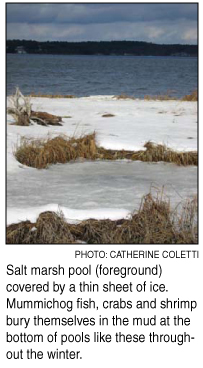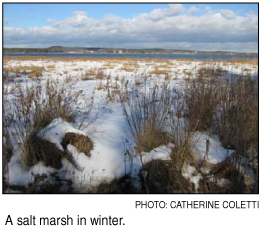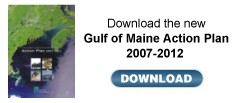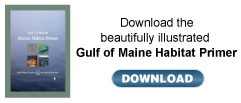Gulf Voices
Awakening the marsh
By Catherine Coletti
 The sun glares off the snow, which blankets most of the ground
on the salt marsh. I can see my breath in the air. The sun glares off the snow, which blankets most of the ground
on the salt marsh. I can see my breath in the air.
We squint in search of the Canada geese and ducks that come
to spend the winter here. Species such as American black ducks,
mallards and American widgeon will forage for seeds, stems, leaves
and even snails and small clams on the exposed mud flats of the
low salt marsh when the tide is out. Today we spot the silhouettes
of crows, adept scavengers in many surroundings, including this
one.
My tour guide is Steve Miller from the Great Bay Discovery
Center in Greenland, New Hampshire. He said, “There’s
still some deep holes, so watch your step.” I forgot to wear
gloves, left my hat in the car and can feel my ears turning red
with cold, but I don’t mind because I feel like I’ve
stepped into a scenic painting. On the horizon, the water looks
blue in the sunshine, but when a cloud passes overhead, it becomes
a muted gray.
Above our heads, the dead stems of common reed (Phragmites
australis)—this particular bunch is a native stand (we
can tell because it has lost its leaves)—line the outer edge
of the marsh and rustle dryly in the wind, inviting us to enter.
Once we pass the taller growth, the marsh reminds me of a sort
of winter Wild West, wide open and the wind now whipping around
my hair. The leaves and stems of the smooth cordgrass (Spartina
alterniflora) and salt hay (Spartina patens) are half
buried in the snow in ankle-high clusters. Steve and I weave around
their dead brown tops.
During winter, most of the perennial plants—the plants
that will come back each spring—use energy and nutrients
absorbed by their rhizomes, or underground plant stems, to stay
alive under the ice. The cordgrass has an additional winter survival
strategy: tiny purple-tinged shoots at the base of last year’s
dead growth connect the roots and rhizomes to the oxygen in the
air above. In the spring, the purple shoots do not grow bigger,
their job having been completed.
Steve and I come across a pool covered with a thin sheet of
ice. Most likely there are mummichog fish, crabs and shrimp buried
in the mud at the bottom of the pool, where they will stay until
the sun’s warmth and light sends them the memo to come out.
Snow acts as an insulator, keeping the creatures underneath protected.
Burrowed in their winter homes, they are oblivious to the influx
of the tides, which bring seawater in and out twice a day. The
velocity and depth of the tides fluctuate with the position of
the moon in an ancient dance.
During low tides, thin layers of ice form across the marsh
and freeze to the plants and peat, or soil filled with organic
matter. If freezing temperatures remain in an area sheltered from
wave action, the ice deepens, reaching thicknesses of 1 to 2 feet
(30-60 centimeters). In an amazing process called ice rafting,
the ice chunks get sucked away by the outgoing tide, taking hunks
of peat and plants with them. The plants hitchhike to new locales,
sometimes deposited in marsh areas to take up residence, and sometimes
doomed to sub-tidal habitats where they can’t survive. Steve
said he has seen ice chunks the size of bathtubs with plants sticking
out of them floating out of Little Harbor, when he worked at the
Seacoast Science Center along the Atlantic shoreline in New Hampshire.
 Ice rafting also happens in rocky areas, where it rips away
the fucoid, or brown algae that grows there, including knobbed
wrack (Ascophyllum nodosumm), which is commonly recognizable
as seaweed. However, if deposited in a marsh, the fucoid algae
ultimately form free-living plants that appear quite different
than their original sources. Plants or animals produced in response
to habitat factors such as ice rafting are called ecads. Typically
the fucoid ecads grow entangled within the cordgrass and form
extensive biomass, particularly during the spring, prior to the
extensive growth of the cordgrass. Both the cordgrass and the
fucoid algae are important sources of detritus, or dead plant
and animal matter, within salt marshes, providing energy to the
marsh system. Ice rafting also happens in rocky areas, where it rips away
the fucoid, or brown algae that grows there, including knobbed
wrack (Ascophyllum nodosumm), which is commonly recognizable
as seaweed. However, if deposited in a marsh, the fucoid algae
ultimately form free-living plants that appear quite different
than their original sources. Plants or animals produced in response
to habitat factors such as ice rafting are called ecads. Typically
the fucoid ecads grow entangled within the cordgrass and form
extensive biomass, particularly during the spring, prior to the
extensive growth of the cordgrass. Both the cordgrass and the
fucoid algae are important sources of detritus, or dead plant
and animal matter, within salt marshes, providing energy to the
marsh system.
Avoiding all of that above-ground winter upheaval, the horseshoe
crab—whose name is a bit of a misnomer as it is not a crab
species but is related to spiders and scorpions—moves to
deeper and warmer waters and waits for spring burrowed in the
mud, sometimes with only its tail sticking out. Many resident
New Hampshire horseshoe crabs overwinter in Great Bay and Little
Bay, and will migrate to the shallower waters near the marsh when
the water hits about 10 degrees Celsius (50 degrees Fahrenheit).
This spring, increasing light and warmth will tell the marsh
to wake up, melting the snow and splattering green across it like
a modernist painter. The melting away may reveal a weathered face,
as ice, tides and waves have chipped away at its fragile outer
edges.
Due to the cold ocean water brought in by the tides, salt marsh
plants grow a bit later than inland ones, and most make their
spring debut around mid May. Also around that time, the horseshoe
crabs will be spawning at the high tide line, their eggs providing
food for many bird species, some of which rely on the additional
energy to migrate.
This spring, the animals and plants and land and water will
continue their inter-relationships into summer, fall, and then
return to another winter, where dark and cold will tell them to
die back, slow down and once again wait to emerge into life.
Catherine Coletti is assistant editor of the Gulf of Maine
Times.
|








